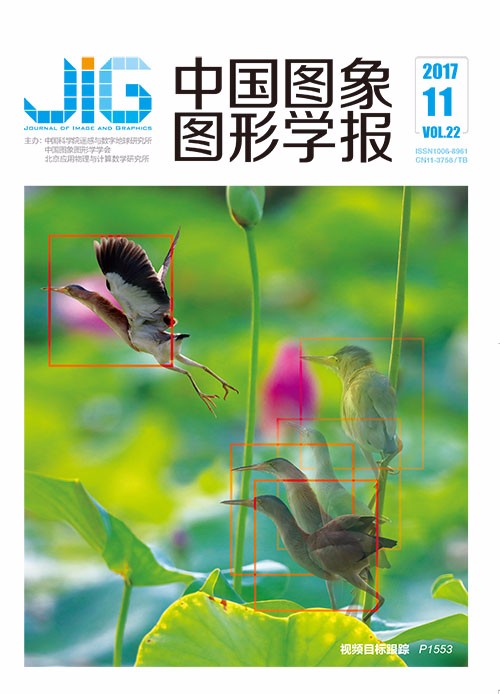
非下采样剪切波变换的医学图像融合
摘 要
目的 由于单模态医学图像所提供的信息有限,不能反映相关组织所有细节信息,可能会造成临床医学误诊。针对这一问题,提出一种基于非下采样剪切波变换(NSST)的医学图像融合算法,对多模态医学图像进行融合,丰富融合图像信息,提高图像质量,为临床诊断提供依据。方法 首先,将源图像进行NSST变换得到低频子带和若干高频方向子带;其次,根据低频子带图像的特点,提出低频系数与脉冲耦合神经网络PCNN (pulse coupled neural network)相结合的方法;根据高频子带间结构相似度SSIM (structure similarity)不同,分为低相似和高相似子带图像;对低相似子带系数采用视觉敏感度系数VSC (visual sensitivity coefficient)与改进梯度能量相结合的策略;高相似子带系数采用VSC与区域能量相结合的方法;进而,选取结构相似度与边缘信息评价因子QABF(edge based similarity measure)之和作为目标函数,自适应地优化可调参数;最后,经逆NSST变换重构图像。结果 对灰度图像和彩色图像进行实验仿真,并与其他4种融合方法进行比较,在主观视觉效果和客观评价标准,本文方法取得良好的融合效果,其中边缘评价因子和标准差都是最好的,其他指标相对较好;与靳珍怡提出的基于非下采样轮廓波变换的多模态医学图像融合相比,5组实验空间频率分别提高了11.8%、24.7%、83.4%、11.9%、30.3%;边缘评价因子分别提高了6.7%、15%、40%、50%、12%;结构相似度分别提高了0.7%、7.3%、2.4%、-3.6%、2.1%;交叉熵分别降低了16.9%、1.6%、-27.4%、6.1%、0.4%。结论 本文算法有效提高多模态医学图像融合质量,增加不同模态间的互补信息;与现有医学图像融合算法相比,本文算法更加优越。融合图像细节信息更为突出,整体信息更丰富,更符合人眼视觉特性。
关键词
医学图像融合 NSST (non-subsampled shearlet transtransform)变换 PCNN (pulse coupled neural network) VSC (visual sensitivity coefficient) 梯度能量 结构相似度
Medical image fusion using non-subsampled shearlet transform
Lou Jianqiang1, Li Junfeng1, Dai Wenzhan2(1.Institute of Automation,ZhejiangSci-Tech University,Hangzhou 310018,China;2.School of Information and Electronic Engineering,ZhejiangGongshang University,Hangzhou 310018,China) Abstract
Objective Information of the single-modality medical image is limited;thus,it cannot reflect all the details of relevant organizations and may cause misdiagnosis in the clinical setting.A scientific and effective fusion algorithm is proposed to fuse multimodal medical images,enrich fusion image information,and improve image quality to provide the basis for clinical diagnosis and solve previously mentioned problem.Method A medical image fusion algorithm based on non-subsampled shearlet transform (NSST) is proposed.First,low-and high-frequency sub-bands are obtained using NSST.Then,on the basis of the low-frequency sub-band image feature,a fusion rule based on low-frequency coefficients combined with pulse-coupled neural network is adopted for low-frequency sub-band images.On the basis of the different structural similarities (SSIM) of high-frequency sub-band images,the fusion rule of combined visual sensitivity coefficient (VSC) with improved gradient energy is adopted for low SSIM sub-bands,whereas the fusion rule of combined VSC with regional energy is applied for high SSIM sub-bands.Furthermore,a closed-loop feedback is introduced into the fusion rule to optimize variables adaptively using the sum of the SSIM and edge-based similarity measure(QABF) as objective evaluation.The image is restructured by inverse NSST.Result Experiments are conducted on gray and colored images and compared with four other types of fusion methods in terms of subjective visual effect and objective evaluation criteria.This method exhibits a good fusion effect.The factors and evaluation criteria of edge difference are the best,whereas other indicators are better.Compared with the multi-modality medical image fusion method based on non-subsampled contourlet transform by Jin zhenyi,five groups of spatial frequencies were increased by 11.8%,24.7%,83.4%,11.9%,and 30.3%;edge-based similarity measures were increased by 6.7%,15%,40%,50%,and 12%;SSIM were increased by 0.7%,7.3%,2,4%,-3.6%,and 2.1%;and cross-entropy measures were decreased by 16.9%,1.6%,-27.4%,6.1%,and 0.4%.Conclusion The proposed algorithm can effectively improve the quality of multimodal medical image fusion and increase the complementary information among different modalities.This algorithm is superior to existing medical image fusion algorithms.The fused image has more grand character and equally abundant and more in accord with human vision character.
Keywords
medical image fusion non-subsampled shearlet transtransform (NSST) pulse coupled neural network (PCNN) visual sensitivity coefficient (VSC) gradient energy structure similarity
|



 中国图象图形学报 │ 京ICP备05080539号-4 │ 本系统由
中国图象图形学报 │ 京ICP备05080539号-4 │ 本系统由